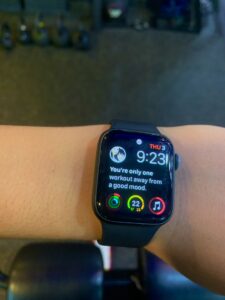One of the most common questions fitness professionals get is how to lose weight without tracking. Well, here are some ways to do just that.
There is no magic behind the science of losing weight. There is no getting past the calories-in versus calories-out formula.
However, beyond the well-spread suggestions that one should work out consistently and eat well, you can leverage a myriad of tools to make weight loss a little smoother.
This article, therefore, doesn’t relate to how to eat better or train more consistently. Rather, it is a short but reliable list of habits you can adopt that will help you to lose weight without tracking calories.
I can definitely say that I have seen significant improvements by adopting some of these suggestions. The changes are reflected in my weight, overall mood, and other health markers.
The suggestions below have been sourced from reliable and peer-reviewed scientific research.
This blog post is all about the tools you can leverage to lose weight without tracking your calories!
HOW TO LOSE WEIGHT WITHOUT TRACKING
Back to Basics: Calories In vs Calories Out
Before anyone comes at me, let me state the following: there is no getting around the basic structure of calories in vs calories out. You NEED to burn off more calories than you eat to lose weight.
In other words, no amount of practicing the suggestions below will allow you to lose weight if you are not in a calorie deficit.
Whether you are already in a calorie deficit or will be getting into a calorie deficit by using these suggestions, the principle is still the same: you need to be in a calorie deficit.
1. The 5 Pillars of Metabolism
You can’t learn to run before learning how to walk. In more relevant terms, you can’t hope to lose weight smoothly if you don’t have some basic routine of healthy practices.
In fact, weight loss is heavily related to the health of your metabolism. If the latter is out of whack, weight loss will be harder, especially if you’re trying to lose weight without tracking.
Therefore, below are the 5 pillars that contribute most to the health of your metabolism. I am not saying that you have to be perfect in all 5 (I’m not even perfect in all 5), but having at least 3 of these solidly built will be important.
Take note
5 Pillars of Metabolism
1. SLEEP
You need to be getting at least 7 hours of sleep every night. I cannot emphasize how crucial to metabolic health this is. Countless restorative processes happen as you sleep.
2. EPA ESSENTIAL FATTY ACIDS
There are 3 types of essential fatty acids: EPA, DHA and ALA. You want to aim for at least 1,000mg of EPA per day. Fatty fish, krill oil, fish oil supplements and other supplements are a great source of EPA.
3. GLUTAMINE
This one is particularly good for people that find themselves craving sugar, or who have leaky gut. In any case, glutamine pairs with EPA in terms of importance. A teaspoon of glutamine a few times a day is enough, though you need to ease into this as it can cause GI distress.
4. THYROID
The best way to support your thyroid system is by ingesting enough selenium. The food with the highest concentration of selenium are Brazil nuts! 1-3 a day is largely enough.
5. MICROBIOME
Very important too! Ingesting 1-2 servings a day of fermented food is a good place to start. Though each culture has their own version of fermented food, common ones are kimchi and sauerkraut.
2. Shift Your Mindset
I know you didn’t come here to hear a motivational speech about how you need to 

Well, maybe a little bit.
Before you skip this bit, this is truly based on scientific outcomes. Indeed, research shows that people simply telling themselves that they are being healthy leads to weight and fat loss, a decrease in blood pressure levels and waist-to-hip ratio.
The way you think about your weight-loss journey is important. Do not think of it as something you’re going through because you hate yourself. Do not think of it as only an uphill battle that you are bound to lose.
Do it because you believe that you deserve to be in better shape. Whatever it is, find the positive reason why you are doing it, stick to it, and tell yourself that you will make it.
Nutrition Coaching
Train hard. Eat well. Build your body one day at a time.
Train hard. Eat well.
Build your body one day at a time.
1-to-1 coaching. A sustainable nutrition plan. A lifetime of knowledge.
3. Fidgeting
Have you ever heard of NEAT? Well, you might want to join the club.
Indeed, since the 1980s, there has been much research accounting for the benefits of subtle and low-energy movements for fat loss. Indeed, adopting movements such as knee bouncing, finger taping or pacing may help one burn anywhere from 20% to 30% more calories throughout the day.
On another note, this technique seems to help those who are slightly overweight the most. So for anyone who is exercise-averse, this might be a good starting point.
Though fidgeting will not compensate for chronic overeating, it can help balance off certain meals that were too big or that extra cocktail you had at the bar.
Take note
What is NEAT?
NEAT stands for non-exercise activity thermogenesis. It refers to all the energy expenditure (aka calorie burn) that is NOT a result of intentional exercising, eating or sleeping.
Examples of NEAT are mowing your lawn, picking up kids, pacing while on the phone, or taking the stairs.
Actually, one should be partaking in as many NEAT activities as one can throughout the day. If you want a simple way to be healthier all around as well as lose weight without tracking, this would be one of the most powerful tools. So time to park that car further away from Costco’s main entrance.
4. Cold Plunges (+ the exact protocol to follow)
Yes, it is true. Ice baths do indeed help with your fat loss. However, there are some crucial details that have not made headlines.
According to 2019 research, if you want to benefit from the fat-burning side-effects of a cold plunge, then you have to allow yourself to shiver. Indeed, contrary to what you might have heard, it is the actual shivering (similar to the fidgeting) that allows your metabolism to burn more fat.
Furthermore, another important detail that has been lost is the fact that you do NOT want to get used to the cold. That is why you do not want to be doing cold plunges more than 3-4 times a week – indeed, benefits can already be drawn from doing a single cold plunge a week.
For a more detailed protocol, try the following steps. Get into a cold body of water (shower, ice bath, lake, etc). From the moment that you shiver, stay in there for about 1-2 minutes. Then, get out of the water but do not dry off. Stay outside for 1-3 minutes. Get back into the water and repeat for a total of 3 circuits.
Remember, it is important that you do not get used to the cold. Obviously, you do not want to start so cold that you shock your system badly (as it can lead to heart attacks in the worse of cases). Beginning at around 15°C (60°F) is a good place to start.
How do cold plunges for fat loss work? Well, it is complex, but it mostly relates to a hormone called succinate. Upon release, this hormone acts on brown fat (a type of fat) to increase the release of heat – and thereby calorie expenditure. This is a very superficial explanation but that’s as much as you need to know for now!
Take note
Other benefits of cold plunges
Cold plunges have gained popularity in recent years as a wellness practice. Some other benefits of cold plunges include:
- Reduced inflammation: Cold water immersion can help reduce inflammation in the body by constricting blood vessels and decreasing blood flow to areas of inflammation.
- Increased circulation: The cold water causes your blood vessels to constrict, which helps to increase blood flow and oxygenation to your muscles and other tissues.
- Improved recovery after exercise: Cold water immersion can help to reduce muscle soreness and fatigue after exercise, and may help to speed up recovery time.
- Boosted immune function: Cold water immersion may help to boost the immune system by increasing the production of white blood cells.
- Improved mental health: Cold water immersion has been shown to improve mood and reduce symptoms of anxiety and depression.
- Increased alertness and energy: Cold water immersion can increase alertness and energy levels, making it a great way to start your day.
It’s important to note that cold plunges may not be suitable for everyone, and it’s always a good idea to consult with a healthcare professional before starting any new wellness practice.
5. Fasting & the Types of Exercise
This is a hefty subject. So bare with me.
For the sake of this section, I will divide exercise into 3 categories:
- Sprint Interval Training (SIT). You are training at over 100% of your VO2 max. The activity lasts 8-20 seconds, with short 1-2 minute breaks in between.
Examples: Short-length sprints, heavy resistance training - High-Intensity Interval Training (HIIT). You are training at 80-100% of your VO2 max. The activity lasts 60-120 seconds.
Example: circuit training - Moderate Intensity Continuous Training (MICT). You are training at 60-70% of your VO2 max. The activity lasts 20+ minutes, continuously.
Example: long-distance running, hiking
Let’s start with what would happen if you were to work out fasted (aka not having eaten at least 3 hours prior to the workout). It is no secret that increased insulin (caused by eating carbs) will reduce the amount of fat burned DURING exercise. Therefore, working out fasted would cause you to burn more fat during the workout. HOWEVER, out of all the research that confirms this fact, there has been little emphasis on what TYPE of exercise the subjects were performing.
First, this research shows that if you were to train for under 30-45 minutes, then training fasted will not change the amount of fat burned DURING your workout.
However, this is not the case if you were practicing a MICT type of workout. Indeed, there seems to be a 90-minute switch-off point. Had you fasted before this workout, your body will have started to burn more fat after the 90-minute point than if you had eaten before the workout.
A 90-minute MICT workout is pretty long, especially if you are going into it fasted. Thankfully, there are times when being fasted are easier than others. For example, if you were to be going on a long 90-minute+ walk, then you could do that fasted. Hiking is another activity where time seems to go by quicker, making this easier.
Note that there is nothing magic about this 90-minute point. The harder you were to work out, the earlier this switch-off point would be. Basically, this point occurs when you have depleted your glycogen (sugar) levels in your system, thereby forcing your body to use other sources of energy – here being fat.
Take note
What happens after the workout?
There is something to say about the calories burnt AFTER a fasted or not fasted workout. It’s actually a reversed phenomenon.
I mentioned that DURING your medium-intensity workout, you burn more fat. However, AFTER this workout, you tap into your glycogen storage for energy.
As for high-intensity workouts, you burn more glycogen DURING the workouts. However, AFTER the workout, you tap into your fat storages a lot more.
Keeping all this in mind, here is a protocol that you could follow to deplete your glycogen levels to achieve the greatest fat-loss results:
- Do some form of high-intensity training for 20-60 minutes, such as weight training. Here, feel free to eat before the workout.
- After finishing this, move on to some form of MICT training, such as running on the treadmill. Indeed, your glycogen levels will have likely depleted significantly during the weight training, therefore lowering that switch-off point.

Want a free
DAILY WORKOUT PLANNER?
Watch how your performance, physique and goals improve just by the simple task of using a Workout Planner. Fill out the form below and have the Workout Planner delivered straight to your inbox!
6. Caffeine 30-40 minutes prior to exercise
The details as to how caffeine prior to exercise is beneficial relate to exactly how fat is burned. If you are uninterested in this science, then all you need to know is that if you are caffeine adapted, ingesting 100-400mg of caffeine prior to exercise can help burn off fat.
If you are interested, then here is a brief explanation. There are 2 steps to what we know as burning fat:
- Fat mobilization. We want to “detach” the fat from where it is being stored. Succinctly, stored fat is made up of fatty acids (the part that is used for energy) which are linked to glycerol. Mobilizing fat, therefore, refers to breaking that link and having those fatty acids moving around in the bloodstream.
- Fat oxidation. The fatty acids are potential sources of energy. If they do not get used, they move back into stored fat. Therefore, fat oxidation refers to when these fatty acids move into the mitochondria of cells and are converted into ATP – and therefore burned.
Since your fat is innervated (has nerves), these two steps are favoured by your nervous system. Indeed, it can favour fat mobilization and oxidation by releasing adrenaline into the fat cell.
In summary, increasing the amount of adrenaline available can increase the rate of fat mobilization and oxidation.
Therefore, since drinking caffeine increases our levels of alertness and levels of adrenaline, then it can also increase the rate of fat mobilization.
7. Yerba Mate and Guayusa
Yerba mate, an Argentine tea, increases GLP-1. GLP-1 is in the glucagon pathway. This pathway facilitates the conversion of fatty acids into ATP, which, as we saw, is the basis of fat oxidation.
Therefore, drinking Mate (or Guayusa) will both allow for greater rates of fat oxidation. Also, it has been shown that Yerba Mate also helps increase metabolic rate in general if sipped throughout the day!
Note that semaglutide is the prescription drug version of GLP-1. Indeed, many dislike the taste of Yerba Mate because of its strong and bitter taste. Another alternative is Guayusa, a sweeter Ecuadorian tea.
8. L-Carnitine
L-Carnitine, or Acetly-L-Carnitine, helps convert fatty acids into ATP which in turn helps fat oxidation. And indeed, it has been shown that L-Carnatine helps with fat loss.
People typically ingest 500mg to 2g of L-Carnitine per day. And if you’re really intense, you could also take injectables. (Obvs, check with your physician!)
Beyond the benefits of fat loss, L-Carnitine has proven to be a source of many other benefits for cellar metabolism. In fact, it can reduce ammonia and C-reactive protein levels. It can also reduce blood glucose, cholesterol and blood pressure. It also increases the rates of pregnancy as well as sperm quality and mobility, while decreasing fatigue during exercise.
Intuitive eating, aka to lose weight without tracking, is not an easy journey. I hope these tools have helped you!
This blog post was all about the tools to help you lose weight without tracking calories.
xx LS
Share this post









